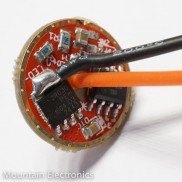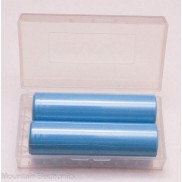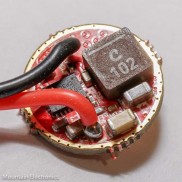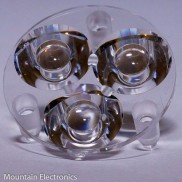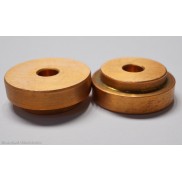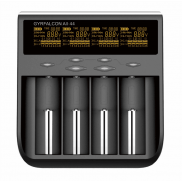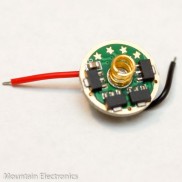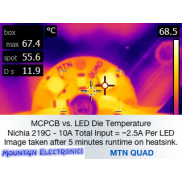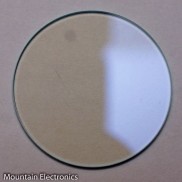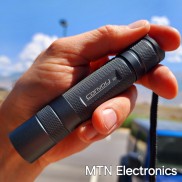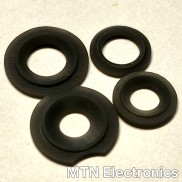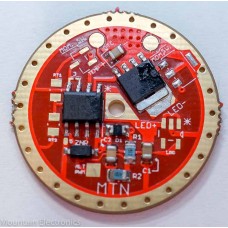Shopping Cart
0 item(s) - $0.0026mm FET + 7135 Driver - MTN-26DDm - 2S-4S Input Voltage (Clicky)
Availability: 15
Add to Compare
This 26mm FET+7135 driver features an ultra low resistance FET that gives you near-direct-drive performance (limited mostly by your battery, LED, and connections) with the ability to still use lower power levels, among other functions such as low voltage protection.
Some of the firmware options use only the FET and not the 7135. See the listing below.
For the 1S (single lithium-ion cell) version, click here.
Because each driver is hand-built and tested, This driver may take up to 10 business days to build, test, and ship.
Wires + Spring Option
There are four different options for how you would like your driver to be configured:
- Driver Only - No Spring or Wires - Generally ships within 3 business days
- Driver + Wires Installed - No Spring - Generally ships within 3 business days
- Driver + Spring - No Wires - Generally ships within 3 business days
- Driver + Wires + Bypassed Spring - Generally ships within 3 business days
FIRMWARE OPTIONS (FET+7135)
Bistro Clicky Firmware (attiny25)
ToyKeeper hit this one out of the ballpark! This is similar to the BLF A6 firmware, but with a lot more options. For more information, click this link.
Firmware Options (FET Only)
Standard Clicky Firmware (attiny13a)
- Standard FET with Memory. This is the most popular option. Equipped with off-time memory, mode changes are intuitive and the light always picks right back up where you left off.
- Mode Levels: Moonlight - 2% - 5% - 20% - 50% - 100%
- Standard FET with No Memory. This is the second most popular option. Equipped with off-time no memory, the light will always start on the first mode level after being turned off.
- Custom Mode Levels. Choose your own mode levels. For this option, please enter the following information in your checkout comments:
- 1. Number of light levels: 1-6 (plus moonlight if desired)
- 2. Approximate PWM levels of each mode: Example: (1) 2% - (2) 15% - (3) 40% - (4) - 100%
- 3. Memory or No Memory
Clicky Pin Functions. Soldering these numbered pins to ground will enable these features:
- 3 reverses mode order from the standard ascending (low to high) to descending (high to low).
Standard Clicky Firmware Low Voltage Protection. With 2S cells, at around 6V under load (3S: ~9V; 4S ~12V) the light will blink three times then step down the power level. At around 5V under load (3S: ~7.5V; 4S: ~10V) the light will blink ten times then shut off. This system gives you ample warning and attempts to extend runtime before turning the light off.
Universal guppydrv Clicky Firmware Option
This firmware allows the ultimate in user customizability, with up to 24 built-in mode groups, that the user can select via a series of button presses and a user programmable turbo timer that will automatically step the power down to 50% after the set time is hit (see below for instructions).
Low voltage protection: With 2S cells the light will begin to step down output at around 6V under load; 3S ~9V; 4S ~12V. The light will not shut completely off, but will continue to run at a moonlight level.
Rev.1 User Selectable Groups:
- 1% - 25% - 100% | Memory
- 1% - 25% - 100% | No Memory
- 100% - 25% - 1% | No Memory
- 1% - 25% - 100% - Strobe | No Memory
- 1% - 25% - 100% - Strobe | Memory
- 10% - 100% | Memory
- 10% - 100% | No Memory
- 100% - 10% | No Memory
- 100%
- 100% - Strobe | No Memory
- Strobe - 100% | No Memory
- ML - 2% - 25% - 100% | Memory
- ML - 2% - 25% - 100% - Strobe - Beacon | No Memory
- ML - 100% | No Memory
- 100% - ML | No Memory
- ML - 100% | Memory
- ML - 1% - 5% - 15% - 40% - 100% | Memory
- ML - 1% - 5% - 15% - 40% - 100% | No Memory
- 100% - 40% - 15% - 5% - 1% - ML | No Memory
- 100% - 40% - 15% - 5% - 1% - ML | Memory
- 1% - 5% - 15% - 40% - 100% | Memory
- 1% - 5% - 15% - 40% - 100% | No Memory
- 100% - 40% - 15% - 5% - 1% | No Memory
- 100% - 40% - 15% - 5% - 1% | Memory
Rev.2 User Selectable Groups:
- 100% Only
- 5% - 100% | Memory
- 5% - 100% | No Memory
- 30% - 100% | Memory
- 30% - 100% | No Memory
- 70% - 100% | Memory
- 70% - 100% | No Memory
- ML - 30% - 100% | Memory
- ML - 30% - 100% | No Memory
- 100% - 30% - ML | No Memory
- ML - 5% - 15% - 50% - 70% - 100% | Memory
- ML - 5% - 15% - 50% - 70% - 100% | No Memory
- 100% - 70% - 50% - 15% - 5% - ML | No Memory
- Strobe Only
- 100% - Strobe | No Memory
- Strobe - 100% | No Memory
- 100% - 1Hz Blink | No Memory
- ML - 5% - 30% - 70% - 100% - Strobe - 1Hz Blink | No Memory
- 100% - 70% - 30% - 5% - ML - Strobe - 1Hz Blink | No Memory
- 5% - 30% - 100% - 1Hz Blink - 3Hz Blink - Strobe - Beacon | No Memory
Guppydrv Instructions
To switch mode groups: rapidly tap the switch 8 times, the light will then enter the programming mode and begin to flash. With the light in programming mode, tap the switch the same number of times as your desired mode group. The light will blink and your mode group will be memorized.
Example: To select mode group 3, tap the switch 8 times quickly to enter programming mode. As soon as the light enters programming mode and beings flashing, tap the switch three times. The light will blink to recognize the mode group change.
To set the turbo timer: rapidly tap the switch 8 times, the light will then enter the programming mode and begin to flash. With the light in programming mode, tap the switch 30 times to enter the turbo timer set mode. The light will then switch to 100% power. When the light is at the desired temperature for the turbo step down, turn the light off. The turbo timer will then be set. The turbo timer steps the light down to 50% regardless of the mode group set.
To lock the mode groups: Solder Pin 5 to ground.
Turbo Timer
A turbo timer may help reduce the chance of overheating.
Bistro / guppydrv / moppydrv / D4 V2 firmwares do NOT use a fixed turbo timer. Instead, you program in your own turbo timer or set your temperature sensor level.
FREQUENTLY ASKED QUESTIONS:
1. What Is The Input Voltage Range?
- 6V-18V (2S-4S)
- This is a "direct drive" driver, meaning it doesn't step up or down voltage that the LED sees.
- Examples of workable LED + battery combinations:
- 2S Input (two cells in series):
- 6V XHP50/XHP70
- 6V MT-G2
- Two 3V LEDs in Series
- 3S Input (three cells in series):
- Three 3V LEDs in series
- 4S Input (four cells in series):
- 12V XHP50/XHP70
- Four 3V LEDs in series
- 2S Input (two cells in series):
- Examples of workable LED + battery combinations:
2. What Kind Of Output Can I Expect?
- Output is generally limited by cell selection, LED type, and other connections (such as springs and emitter wires).
This driver was made possible and is heavily inspired by many members of the BLF flashlight community, especially comfychair (initial concept and development), Mattaus (PCB layout and development), JonnyC (firmware), DrJones (firmware), and wight (singe-sided PCB development and advice). If you'd like to learn more about these drivers, and participate in further development, come visit our community at budgetlightforum.com
Write a review
Your Name:Your Review: Note: HTML is not translated!
Rating: Bad Good
Enter the code in the box below:
Mountain Electronics LLC © 2025

